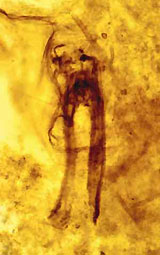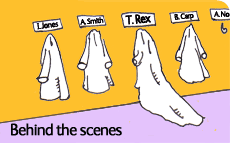The oldest fossil insect in the world
Dr Andrew Ross, Curator of Fossil Arthropods
A specimen that has been sitting in the Museum's collection for over 60 years is confirmed as the world's oldest fossil insect.
Insects have 6 legs which places them in the Superclass Hexapoda. This superclass contains two classes: the Collembola (springtails) and Insecta (true insects), which are separated on the form of the mouthparts.

Rhyniognatha hirsti
The specimen, no. In.38234, is preserved in a fragment of Rhynie Chert and mounted on a glass microscope slide. It consists of a pair of jaws (mandibles) and other associated structures. It was collected by the Reverend W. Cran and is dated 19/06/1919. Cran found many arthropod remains in the Rhynie Chert and made them available for study to S. Hirst, S. Maulik and D.J. Scourfield. Hirst and Maulik published a paper in 1926 and figured this specimen as the 'mandibles of supposed larval insect'. They also described and named four other specimens of well-preserved heads as Rhyniella praecursor. Eminent fossil insect expert Robin J. Tillyard then studied these specimens. He named the jaws Rhyniognatha hirsti in 1928 and described it as the 'portion of a head of a small insect, showing the mandibles and some surrounding structures'. He also identified Rhyniella praecursor as a collembolan (springtail). The specimens were donated to the NHM by Scourfield in 1940.
The Rhynie Chert is a remarkable rock. It comes from the village of Rhynie in Scotland and consists of beds of silica (similar to flint) that were deposited by hot springs 400 million years ago. The chert contains exquisitely preserved plants and animals from the beginning of the Devonian Period and are evidence of the earliest known terrestrial ecosystem in the world.
Since 1928, no-one has doubted that Rhyniella praecursor was a springtail and thus it has been widely regarded as the oldest known fossil hexapod in the world, however Rhyniognatha hirsti has been largely ignored. Various scientists have mentioned Rhyniognatha but most have regarded it as an arthropod of uncertain affinities. In 2002 two American scientists, Dr Michael Engel from the University of Kansas and Dr David Grimaldi from the American Museum of Natural History Museum, New York, visited the Museum to study the fossil insect collections. One of the specimens they asked to see was Rhyniognatha hirsti . From an initial examination they realised it was interesting and borrowed it to take back to the states to study in more detail. There they realised the true importance of the specimen and wrote a paper for the prestigious journal 'Nature' that was published on 12th February 2004.
Engel and Grimaldi found that the mandibles of Rhyniognatha hirsti have two points of articulation (dicondylic) which is only known in true insects: silverfish (Zygentoma) and winged insects (Pterygota). The form of the mandibles is more like that of winged insects than silverfish. Although there is no evidence of wings preserved in the Rhynie Chert, the advanced form of the mandibles of Rhyniognatha indicates that it could have been winged. This is very important as the oldest known fossils of flying insects are 320 million years old; the presence of true insects as far back as 400 million years ago indicates that wings may have evolved much earlier.
Toolbox

Our fossil insect collection includes Rhyniognatha hirsti, the world's oldest fossil insect, dating back some 400 million years.